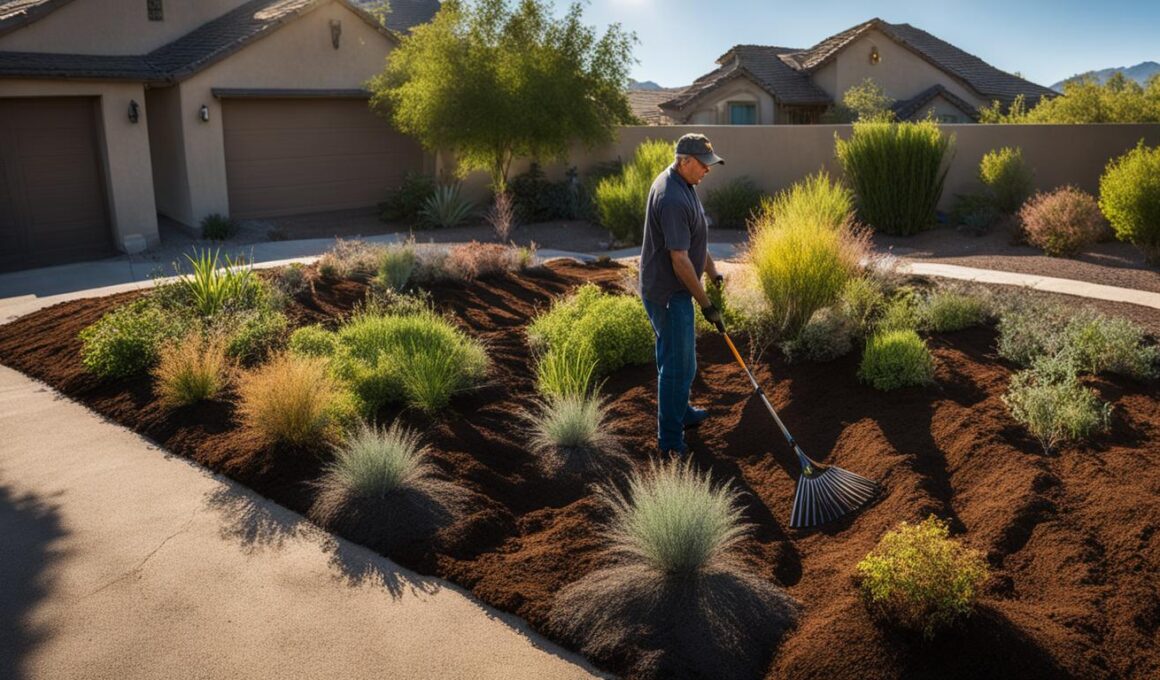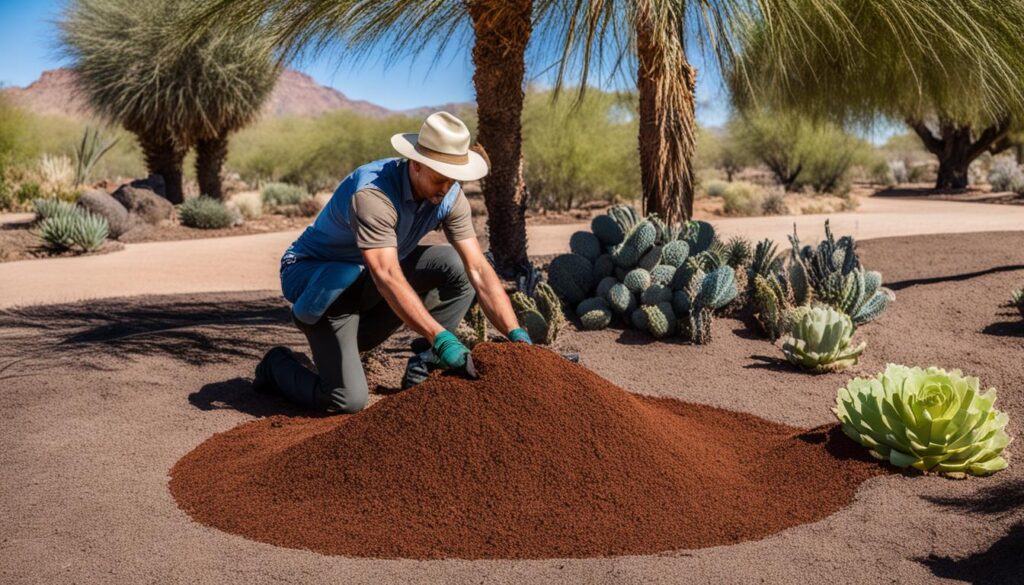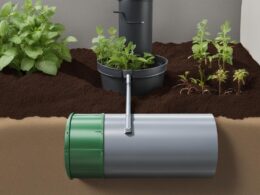Welcome to our guide on mastering mulch maintenance in xeric landscapes. If you have a dry garden or are interested in conserving water while maintaining a beautiful landscape, this article is for you. Mulching is a crucial practice that offers a range of benefits, from retaining soil moisture and controlling weeds to protecting plants and minimizing maintenance. However, it’s important to understand the different types of mulches available and how to choose the right one for your specific needs. Let’s delve into the world of mulch maintenance and discover how you can create a sustainable xeric landscape that thrives.
Key Takeaways:
- Choosing the appropriate type of mulch is crucial for achieving practical benefits in xeric landscapes.
- Mulches can be categorized into inorganic (such as gravel and plastic) and organic (such as hardwood mulch and yard waste).
- Factors like availability, cost, personal preference, soil and climate should be considered when selecting the right mulch.
- Proper mulch application and maintenance are important for maximizing the benefits and aesthetics of xeric landscapes.
- Mulching helps conserve water, control weeds, protect plants, and improve the overall quality of the garden.
Types of Mulches for Xeric Landscapes
When it comes to mulching in xeric landscapes, there are two main types of mulches to consider: inorganic mulches and organic mulches. Understanding the differences between these types will help you choose the right mulch for your garden.
Inorganic mulches, such as gravel, plastic, landscape fabrics, and aluminized mulches, offer unique benefits in xeric landscapes. Gravel and pebbles are excellent for weed control in dry soils, as they create a barrier that inhibits weed growth. Landscape fabric mulches were once commonly used in combination with organic mulches to enhance weed control, but experts now advise against their use due to potential harm to soil health and plant growth. Plastic and aluminized mulches are often utilized in vegetable gardens to promote warmth and moisture retention.
On the other hand, organic mulches are derived from natural materials such as byproducts of the lumber industry, agricultural byproducts, yard waste, and even living cover crops. These mulches provide numerous benefits, including moisture retention, weed suppression, and soil temperature regulation. Organic mulches also improve soil structure, add nutrients, and encourage beneficial microbial activity.
When choosing the right mulch for your xeric landscape, consider the specific needs of your garden, the availability of materials, and your personal preferences. Both inorganic and organic mulches have their advantages and drawbacks, so it’s essential to assess your goals and the unique characteristics of your landscape before making a decision.
| Types of Mulch | Advantages | Disadvantages |
|---|---|---|
| Gravel and pebbles | Excellent weed control Durable and long-lasting Good for drainage in heavy soils |
Can make soil hotter in direct sun May require extra irrigation to compensate for water runoff |
| Landscape fabric | Initial weed control Helps prevent soil erosion |
Potential harm to soil health and plant growth Difficult to remove and replace |
| Plastic and aluminized mulches | Effective in warming soil for vegetable gardens Reduces weed competition |
Can retain too much moisture in wet climates Requires careful monitoring of soil moisture levels |
| Hardwood mulch | Excellent moisture retention Improves soil structure and fertility Reduces erosion |
May attract termites Can decompose and require replenishment |
Choosing the right mulch for your xeric landscape is crucial for its success. Consider the unique characteristics of your garden and the benefits each type of mulch offers. Whether you opt for inorganic mulches like gravel or plastic, or prefer the organic approach with hardwood mulch, make sure to apply the mulch correctly and maintain it regularly for optimal results.
Choosing the Right Mulch for Xeric Landscapes
When it comes to selecting the right mulch for your xeric landscape, there are several factors to consider. Each factor plays a crucial role in determining the most suitable mulch for your specific needs. Let’s explore these factors in detail:
- Mulch Selection: The first step in choosing the right mulch is understanding the different types available. Consider whether you prefer organic or inorganic mulch, such as gravel or landscape fabric. Organic mulches provide additional benefits like adding nutrients to the soil, while inorganic mulches are more durable and long-lasting.
- Availability: It’s important to select a mulch that is readily available in your area. Consider the local availability of mulch materials to ensure easy access and affordability.
- Cost: Mulch prices can vary significantly depending on the type and quantity you require. Take into account your budget and the cost of mulch materials when making your selection.
- Personal Preference: Everyone has their own aesthetic preferences when it comes to the appearance of their landscape. Consider the color, texture, and overall look of the mulch to ensure it aligns with your personal taste.
- Soil and Climate: Different mulches have varying effects on the soil and climate. Consider the characteristics of your soil, such as its acidity or alkalinity, and the local climate conditions. Certain mulches may be more suitable for retaining moisture or regulating soil temperature, depending on your specific needs.
By considering all these factors, you can make an informed decision and choose the mulch that best suits your xeric landscape. Remember, the right mulch selection can make a significant difference in the overall health and appearance of your garden.
Table: Pros and Cons of Different Mulch Types
| Mulch Type | Pros | Cons |
|---|---|---|
| Gravel | Durable and long-lasting Excellent for weed control Retains heat in colder climates |
Less aesthetic appeal Can make soil alkaline if not balanced Requires regular maintenance |
| Landscape Fabric | Effectively suppresses weeds Retains soil moisture Allows for easy water penetration |
Degrades over time Can hinder the growth of plants Difficult to remove once installed |
| Wood Chips | Slowly decompose, adding nutrients to the soil Insulates soil, protecting plant roots Attractive appearance |
Requires regular replenishment May attract pests like termites Can cause nitrogen depletion in the soil |
Remember, each mulch type has its own advantages and disadvantages. Assess your specific requirements and choose the mulch that aligns with both your practical needs and aesthetic preferences. By doing so, you can create a thriving xeric landscape that is not only visually appealing but also sustainable in the long run.
Mulch Application and Maintenance in Xeric Landscapes
Proper mulch application and maintenance are crucial for the health and success of xeric landscapes. By understanding the timing and techniques for mulch application, as well as avoiding common mistakes, you can ensure that your garden thrives. Here are some key considerations to keep in mind:
Timing of Mulch Application
The timing of mulch application can greatly impact its effectiveness. In regions with cold winters, it is recommended to apply organic mulch in late fall or early winter. This helps to prevent rapid freezing and thawing of the soil, which can cause damage to plant roots. In spring, mulch can be applied to inhibit weed growth and reduce soil evaporation. Regardless of the season, it’s important to apply mulch when the soil is moist to promote proper root growth.
Mulch Replenishment
Mulch will naturally break down over time, so it’s important to replenish it periodically. As a general rule of thumb, check the depth of your mulch layer every year and add more as needed to maintain a depth of 2-4 inches. Keep in mind that different mulch materials may break down at different rates, so you may need to adjust the frequency of replenishment accordingly.
Common Mulch Mistakes to Avoid
When applying mulch, be mindful of these common mistakes to ensure optimal results:
- Avoid placing mulch in direct contact with plant crowns or stems, as this can promote rot and disease.
- Do not cover the base of a plant with mulch, as it can lead to suffocation and root damage.
- Be cautious of overusing mulch. Applying too much mulch can create a barrier that prevents water and air from reaching the soil, leading to poor plant growth.
Keeping these guidelines in mind will help you maintain a healthy and thriving xeric landscape. Remember to regularly monitor your mulch layer, make necessary replenishments, and avoid common mistakes to achieve the best results for your garden.
| Mulch Application Tips | Mulch Mistakes to Avoid |
|---|---|
| Apply mulch when the soil is moist. | Avoid placing mulch in direct contact with plant crowns or stems. |
| Spread mulch evenly, maintaining a depth of 2-4 inches. | Do not cover the base of a plant with mulch. |
| Keep mulch a few inches away from the trunk of trees. | Avoid overusing mulch, as it can suffocate plant roots. |
What Are the Benefits of Using Mulch in Xeriscape Landscapes for Erosion Control?
Xeriscape mulching techniques offer numerous benefits for erosion control in dry landscapes. Mulch helps to retain moisture in the soil, reducing the risk of erosion from wind and water. Additionally, it promotes healthy root systems and provides insulation for plants, contributing to the overall sustainability of xeriscaping.
Conclusion
Proper mulch maintenance is essential for the health and aesthetics of xeric landscapes. By choosing the right mulch, applying it correctly, and practicing regular maintenance, you can reap the many benefits mulch provides.
Mulching conserves water by reducing evaporation and retaining soil moisture. This is especially crucial in xeric landscapes where water conservation is important. Additionally, mulch helps control weeds, minimizing the need for herbicides and reducing competition for water and nutrients. It also acts as a protective barrier, shielding plants from extreme temperatures and reducing soil erosion.
With careful consideration of the specific needs of your region, mulching can help create beautiful and sustainable xeric landscapes. So, take the time to choose the appropriate mulch, apply it correctly, and maintain it regularly. Your garden will thank you, and you’ll enjoy a thriving, water-efficient landscape.











